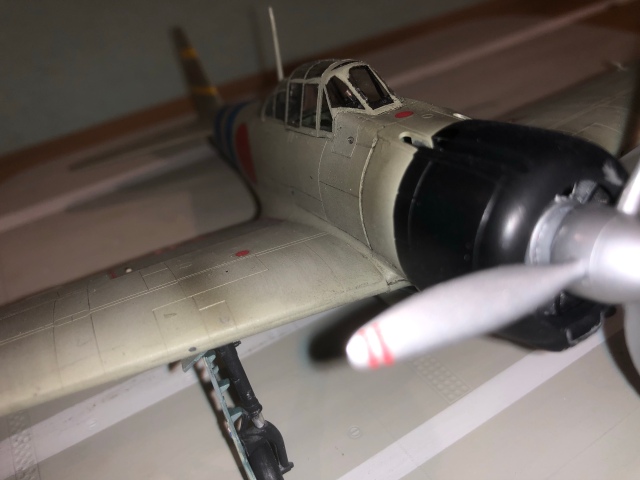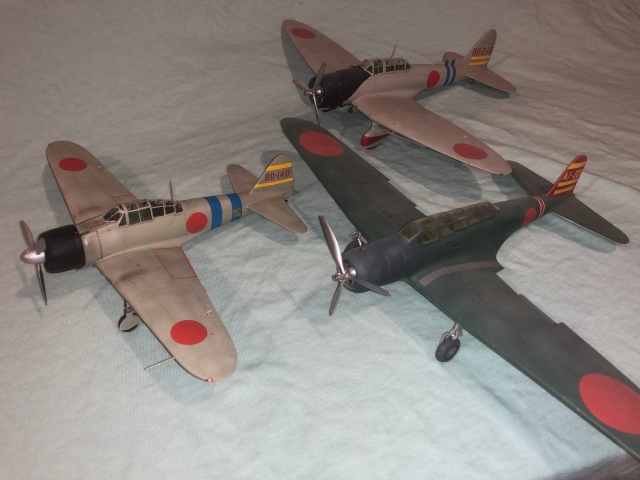Air Raid, Pearl Harbor!
Obviously the most famous Japanese fighter of World War II. The US military was abruptly introduced to the type on December 7, 1941.

Let’s take a look at a participant in that attack.
Of course I’ve looked at this type before, and you know I’ll build some more! Faced with the same engineering math as aircraft designers around the world, Mitsubishi designer Jiro Horikoshi made some specific choices to meet the Imperial Japanese Navy’s criteria. Starting with a top secret metal known as “extra super duralumin” that was lighter and stronger than other Aluminum alloys, and foregoing pilot armor and self sealing fuel tanks, he came up with a clean design that was fast, maneuverable and very long-ranged.
After several attempts to use one of their own engines, Mitsubishi finally gave in to Navy pressure to adopt a Nakajima Sakae 12. This generated 940 horsepower and made the new plane best in its class for 1940.
The IJN was so pleased with the type’s performance they sent the first 13 pre-production aircraft to China before full testing was even complete. It dominated the battlefield as few type’s ever have, at one point scoring 27 victories in three minutes with no losses. Even if those numbers are inflated they show complete ascendancy (10 to 0 is hardly a worse ratio than 27 to 0!).
Observers in China mostly failed to convince outsiders that the type could possibly even be real, and US, British and allied forces played a heavy price for that disbelief from December of 1941.


On December 7, six aircraft carriers launched 350 aircraft in two waves against the Naval base and military installations on Oahu. They inflicted massive damage to naval and air assets while loosing only 29 of their own.
There is no doubt they started a War they couldn’t win, but for the next six months it didn’t look that way. The Japanese, their Navy in particular, looked nearly unbeatable for the opening moves.


This particular aircraft was flown by Lt Sumio Nono of the carrier Hiryu. He was the leader of the 11th Section of the 4th Hikotai, and sadly I don’t really know what that means. Except to mention IJN sections were three airplanes, and there is no way the Hiryu had 33 Zeros on board. My semi-educated guess would be that the “4th Hikotai” is the entire Hiryu air group (The tailcode of Hiryu aircraft was “BII”. This indicates it was the second of two ships of the second carrier division. So maybe 4th air group?) The Hiryu launched 15 Zeros that day, six in the first wave and nine for the second.
Lt Nono led that second wave group of Zeros. They were charged with suppressing Bellows field on the east side of Oahu. So they would have shot down two P-40s that tried to take off during the attack and destroyed one B-17 that attempted an emergency landing there, in addition to shooting up many aircraft that never got off the ground.

Japanese air power on December 7. Zero fighter, Kate torpedo/level bomber and Val dive bomber.
This is the Hasegawa kit with Eagle strike decals. Both are excellent products. This is also the first aircraft I’ve done all major painting with Tamiya paints. For so many years I’d used Model Master, but with the demise of that brand I’m forced to change. The Tamiya paints are excellent quality and I have no complaints with their mixing or application. They really go down nice and smooth! Unfortunately they do not make a very complete selection of American or British colors, so I may be using multiple brands for a while (currently looking at “True North” paints for allied subjects, they mix and thin with Model Master/Testors).

Combatants over Hawaii. This particular Zero would have fought two P-40s that departed Bellows Field.

Its been a couple years, but I finally have the major variants of Zero again!

Beautiful restoration of an A6M2 Zero.

It always makes me laugh when observers on the spot report something only to be told that it couldn’t possibly be true. The British equivalent may have been the men being attacked by Rommel’s Afrika Korps only to be told by Headquarters “That’s impossible. No Germans within two hundred miles !”
I guess to be fair, there are plenty examples of panicked over-reactions too (every German tank is a Tiger!). But yeah, it’s often maddening when someone knew! But no one cared/believed/did anything.
This post has a couple of those; I’m assuming you mean the first reports on the Zero that were all dismissed. But the Pearl Harbor attack has its own maddening history along those lines; from months prior, to a few minutes out. It’s frustrating what a complete surprise it managed to be when there was information out there.
Excellent build and finish of this Zero. I built the Hase zero a couple years ago – went together well enough that I don’t remember any specific build issues except the decals… yuck. I went with Techmod ones. Mine is finished using the Tamiya IJN paint they recommend but I’m getting more and more convinced it had less of a “pistachio” tone and more of a “brown/olive” tone to the paint as can be seen on the USAF Museum zero. When I do another one, I will try something new.
Yeah Hasegawa decals can be a problem. They’re thick, and often don’t do white well. I’ve liked Techmod when I used them. Eagle Strike was an off-shoot of Aeromaster, I think owned by Squadron now, so a dead issue.
I thought the USAF Museum plane had a pistachio cast to it. You are right though that the Tamiya paint still looks slightly different than the Museum plane. But I would add, the restorers are just another sort of modeler. I’m almost positive the colors are all wrong on their Me262. And in my mind’s eye my Zero and the Museum’s Zero are the same color, they just didn’t photograph the same!
There is always a certain amount of speculation in this, and I’m not at all sure how broadly used this greenish grey version of IJN grey even was.
Anyway, I would look forward to seeing another interpretation! Then we can argue or agree some more.
My understanding was that the Zero was a nasty surprise for just about everyone. I think the first experienced group of pilots in decent aircraft (and thus credible) to encounter them were Chenault’s Flying Tigers, and that was shortly after Pearl Harbor. To a certain extent you can forgive the veterans of the European air war who had bested the best (they thought) the enemy had to offer a certain confidence that they would fare better than green pilots in aging aircraft, but still, one should never believe one’s own propaganda.
Yes, although the flying Tigers had pretty much the same airplane as the P-40Bs that were at Pearl Harbor. And of course in the Philippines we had mostly P-40Es, which were a definite improvement and yet were destroyed just as quickly.
As you suggest, a big part of the problem was that the Zero was so different from other front line fighters. Never mind that allied pilots were all green, the instruction they received was all wrong too. Chenault was really the only leader who prepared his men realistically for the Japanese threat.
Yes, while the learning curve was steep and painful it is fortunate that the allies had pilots who figured out how to engage the Zeroes without playing in to it’s strengths, since there was really no fighter that was it’s equal till well in to 1943. I recall some stories about the allied testing of the first Zero captured intact and how impressed they were at it’s construction and performance. I believe there was one Brit (a veteran of Spitfires no less) who called it the best performance fighter he had ever flown.
Yeah actually, Eric Brown, holds several mentions for most types flown, most carrier landings, etc; He stated that the Zero was the best fighter in the world until mid-43.
Several allied types P-40, Wildcat, and Spitfire had enough strengths that they could hold their own when properly flown.
That sounds like who I must be quoting.
His book “Wings of the Luftwaffe” is sort of a war bird “must read”.
Actually it’s probably me quoting you quoting him from one of your previous Zero posts, but why get picky. I’ll put that one on my reading list. I have long been fascinated ny the air war, especially the European theater. I guess the pacific theater interested me so much less because there was no equivalent of “The Battle of Britain” and fine planes that they are, a Hellcat or a Zero doesn’t have the esthetics of a Mustang or a Spitfire, (or dare I say it, even an Me 262) which I found to be a lot more rewarding builds.
I always thought Guadalcanal was a pretty close “Battle of Britain” equivalent. With a lot more naval!
And hey, I’m happy to be your mangled quotable.
“There is no doubt they started a War they couldn’t win…”
I’m starting to think that entering a war with the strategic aim that the enemy will get tired and want to go home is a losing proposition.
Yes, exactly! Well put.
Again I got no notification from WordPress Dave!
Sometimes sites “unfollow” for unknown reasons.
Must be Russian hackers…
Or a new Chinese virus!
Love the comment section also Dave.
It’s good to hear that Pierre.
Nice dave..
Thank you!
Pingback: Mitsubishi A6M2 Model 21 Zero – faujibratsden